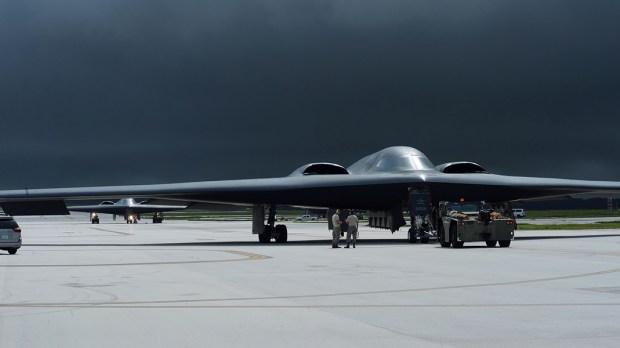Flying close to North Korea, American, South Korean and Japanese military displayed a show of force in response to Pyongyang’s recent firing of a missile over Japan. Sunday’s exercise consisted of a mock bombing drill, which simulated a surgical strike of key enemy facilities, over the Pilsung Range training area in the eastern province of Gangwon in South Korea.
The operation involved four US F-35B fighter jets; two US B-1B bombers, and four South Korean F-15 fighter jets, an official with the South Korean air force told CNN. The U.S. Defense Department also said that two Japanese F-2 fighters joined the mission. The measure was designed to “strongly counter North Korea’s repeated ballistic missile tests and development of nuclear weapons,” the official said.
In a statement, US Pacific Command said the flyover was a “direct response to North Korea’s intermediate range ballistic missile launch.”
“North Korea’s actions are a threat to our allies, partners and homeland, and their destabilizing actions will be met accordingly,” said Gen. Terrence O’Shaughnessy, commander of Pacific Air Forces.
The U.S. and Japanese jets also flew in formation over waters near Kyushu, Japan, a southern portion of the country that is the closest major island to the Korean Peninsula, the Washington Post reported.
“Pacific Command maintains the ability to respond to any threat in the Indo-Asia-Pacific theater at a moment’s notice,” Pacom officials said.
The Air Force said the US bombers flew out of Guam, which was the center of attention this summer, when North Korean leader Kim Jong-un threatened to bomb the U.S. territory. The Pacific island has a U.S. Navy base and a U.S. Air Force base, and is the United States’ closest territory to North Korea.
Pyongyang renewed its threat against Guam this week. The state-run Korean Central News Agency said that the missile launch over Japan last Tuesday was “a meaningful prelude to containing Guam,” which it called the “advanced base of invasion” for US forces. In a follow-up statement Thursday, the agency promised future launches “targeting the Pacific, where the US imperialist aggressor forces’ bases are stationed.” Ominously, it added: “It should not be forgotten even a moment that the whole of South Korea can turn into ruins.”
The war of words and new show of force takes place while North Korea has increasingly threatened to develop, and tested, nuclear weapons and intercontinental ballistic missiles that could carry them to the U.S. mainland. Nikki Haley, the U.S. Ambassador to the United Nations, said that if the U.S. runs out of diplomatic options in the crisis, military force is an option.
“If North Korea keeps on with this reckless behavior, if the United States has to defend itself or defend its allies in any way, North Korea will be destroyed,” Haley told CNN in an interview that aired Sunday. “And we all know that, and none of us want that.”
But Stephen C. Meyer, director of the Center for Science and Culture at the Discovery Institute in Seattle, wrote in National Review that a third option worth exploring is improving America’s missile defense systems. One particularly promising system, he says, is the High Altitude Long Endurance Boost Phase Intercept:
The HALE BPI system would host anti-missile missiles on existing unmanned aerial vehicles (UAVs) that have the capacity for continuous flying for 18 to 40 hours or more (thus, the term “long endurance” in the HALE acronym). Using sophisticated radar, infrared detection, and “data fusion” technology, these missile-equipped UAVs would circle the Sea of Japan outside North Korean airspace at an altitude of 45,000 feet or more. Upon detection and verification of a missile launch from North Korea, the HALE BPI UAV’s operator on the ground would have time (perhaps a minute or more) to fire a purely kinetic missile, i.e. a missile without an explosive warhead, at the missile in its “boost phase.” Using already existing guidance systems and the pure kinetic energy that can be generated by even a small object moving at an extremely rapid velocity, the missile would destroy a North Korea missile almost as soon as it leaves the launch pad.

